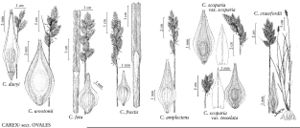Carex crawfordii
Proc. Amer. Acad. Arts 37: 469, plate 1, figs. 12–14. 1902.
Plants densely cespitose. Culms 25–60 (–85) cm; vegetative culms with few leaves clustered at apex. Leaves: sheaths adaxially white-hyaline, summits U-shaped; distal ligules 1.5–6 mm; blades (2–) 3–4 (–5) per fertile culm, 7–22 cm × 2–4 mm. Inflorescences erect, usually dense, green, gold, or dark-brown, 1.8–3 cm8–14 mm; proximal internode 2–3 (–5) mm; 2d internode 1–3 mm; proximal bracts bristlelike, shorter than or equaling inflorescences. Spikes 6–14, distant, distinct, ovoid to broadly ovoid, 8–10 × 4.5–6.5 mm, base and apex acute to truncate. Pistillate scales gold to dark-brown, with whitish, green, or brown midstripe, lanceolate, 3–3.8 mm, shorter and narrower than perigynia, apex acuminate to short-awned. Perigynia ascending, white to gold or light-brown, 0–5-veined abaxially, 0–4-veined adaxially, narrowly lanceolate to narrowly ovate, flat except over achene or, occasionally, planoconvex, 3.4–4.1 (–4.7) × 0.9–1.3 mm, 0.15–0.35 mm thick, margin flat, including wing 0.1–0.2 mm wide, usually crinkled distally; beak brown or redbrown at tip, flat, ± ciliate-serrulate, abaxial suture inconspicuous, distance from beak tip to achene (1.8–) 2.1–3 mm. Achenes ± elliptic, 1.1–1.5 × 0.6–0.8 mm, 0.15–0.35 mm thick; style usually persistent, sinuate. 2n = 52, ca. 66, 70.
Phenology: Fruiting late spring–summer.
Habitat: Often in standing water, moist to wet places, open, sandy, dryish disturbed areas
Elevation: 100–1500 m
Distribution

Alta., B.C., Man., N.B., Nfld. and Labr., N.W.T., N.S., Ont., P.E.I., Que., Sask., Yukon, Alaska, Conn., Idaho, Maine, Mass., Mich., Minn., Mo., Mont., N.H., N.J., N.Y., Oreg., Pa., Vt., Wash., Wis.
Discussion
Selected References
None.
Lower Taxa
"shortened" is not a number."-4.1mm" is not declared as a valid unit of measurement for this property."+timesaslongasinflorescences" is not declared as a valid unit of measurement for this property."not undefined" is not a number."shorter and narrower" is not a number.
